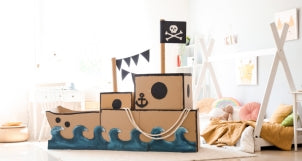STEM is an abbreviation of four words: Science, Technology, Engineering, Maths. Instead of separating each subject to teach children, STEM uses an interdisciplinary approach, posing a problem and requiring children to use all of their knowledge to solve it.
This method is currently being widely applied in many schools with the desire to create a proactive and creative future generation. Many parents also want to let their children learn with this method at home but don't know how, so please refer to how to make STEM toys shared by Mykingdom!
How to make STEM toys: Foosball
In the past, marbles were often used to shoot marbles. Later, marbles gradually moved onto the foosball table and became an exciting fighting sport. The game table usually consists of plastic players mounted on iron bars, players will move the players to defend and try to kick the foosball into the opponent's goal.
To make STEM toys, you need to prepare
- 1 paper box (can use shoe box or instant noodle box)
- Wooden clamp
- Round wooden chopsticks
- Nail clippers or scissors
- Crayon
- Foosball
Making
Step 1: Use pliers to punch a row of holes on the horizontal surface of the paper box, each hole is about 3-4 cm apart depending on the size of the box (Note, the number of holes must be an even number)
Step 2: Insert the wooden chopstick through the punched hole
Step 3: Take a wooden clip and clip it to each chopstick. The wooden clip will be a player on the field, the number of wooden clips gradually decreases towards the goal.
Step 4: Add the foosball and start the battle.

The foosball table gives children extremely fun moments
Before starting to make this STEM toy , you can color the toy to make it more eye-catching and then use crayons to draw the player's eyes and mouth. This toy not only trains children's hands, eyes and reflexes, but also requires them to think and strategize meticulously to win. Mykingdom also sells super quality, durable and neat foosball tables . You can buy it for your child to help him develop his skills and intelligence and save time making STEM toys .
Paper frog eats flies
You just need to prepare a green cardboard, a white piece of paper, scissors, a felt-tip pen and a piece of wool. First, fold the two edges of the green cover sheet to the middle and then use tape to secure it. Insert the yarn into the middle then glue the two edges of one end of the paper.
Next, cut a fly shape out of white paper, use a black marker to draw patterns on it, then tie one end of the paper to prevent the string from slipping out when pulled and stick the fly on the tied end of the string. Okay. Finally, you shake the frog's arms and legs and use a pen to draw the frog's eyes and you're done.

The fly-eating frog is cute and very easy to make
Making STEM toys is easy, right? This toy not only helps children recreate frog hunting scenes, but also stimulates curiosity about frog behavior. While children are playing, parents should ask some questions starting with "Why..." to stimulate children's thinking ability.
Maze game
The classic maze game can now be made at home with simple materials. You need a wooden tray, a bunch of round wooden chopsticks, a bottle of wood glue and pearls (can be replaced with marbles).
Implementation steps.
1. Saw the wood into bars of uneven length
2. Glue wooden chopsticks in the shape of a maze
3. Put the pearl in and ask your child to tilt the tray so that the pearl exits the maze.

The classic maze game has now been perfectly recreated
This game requires a lot of observation and thinking ability. If the baby doesn't think and just tilts, it's likely that the pearl will fall into a dead corner and won't be able to get out. This toy for preschool children also enhances children's patience and concentration. Parents, please make STEM toys for your children now.
Rainbow turntable
Making toys for preschool children that both help them have fun and develop soft skills is great, isn't it? Your baby will definitely love the spinning disc with many different colors. They will think about why the colors are mixed when rotating and why the disc spins... Dozens of problems will be raised. and gradually resolve while playing.
Prepare
1 roll of parachute cord or 1 roll of wool
A white cardboard
A cardboard sheet
Colored pens, scissors, glue
Making
Step 1: Cut 2 circles of equal size from white paper and a similar circle from cardboard
Step 2: Use colored pens to draw colorful strips on white cardboard
Step 3: Use scissors to punch 2 holes in the middle of each cover, the distance between the 2 holes is 2-3cm
Step 4: Paste 3 round plates on top of each other, the cardboard will be in the middle
Step 5: Thread the wire into the 2 pre-punched holes and we have finished making the STEM toy .
When playing, your baby just needs to rotate the disc many times to twist the string, then stretch the string out to both sides and the disc will spin super beautifully. You can also buy YOYO toys as an alternative to the rainbow turntable.

The colorful round plate is extremely beautiful
Explore the construction site
You need to prepare a large plastic box, a bag of sand, gravel and small model cars. If your house has a garden, you can directly let your children play in the garden with larger construction model cars instead of making this STEM toy .
You need to pour sand into a plastic box and then spread gravel on one side to create a road with diverse terrain. After that, you will put the construction vehicle in so your baby can play freely. You will think for yourself which truck moves sand, which truck moves gravel and how to create a complete construction site. This toy is truly a choice for children who love to explore construction vehicles.

Mini project right at home, have you tried it yet?
The ways to make STEM toys for preschool children instructed above by Mykingdom are all extremely simple. Which toy does your baby like the most? You can make these toys with your child on the weekend to supplement their STEM skills, while having fun and developing knowledge without being constrained by dry class hours.




